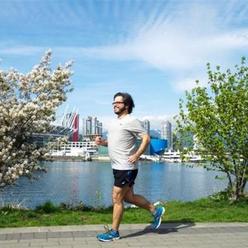Like many niche professions or sub-cultures, runners have their own language that can often seem incomprehensible to novice runners. Here is the third and final installment in my series of posts taking an in-depth look at a “running lexicon” of words you here runners say. If you missed the first two, here they are: Parts I | Part II. ![]() Today, we’ll finish with words starting with the letters P-Z: PR: Personal Record. A term used to describe a runner’s fastest time over a certain distance. Also called Personal Best (PB).
Today, we’ll finish with words starting with the letters P-Z: PR: Personal Record. A term used to describe a runner’s fastest time over a certain distance. Also called Personal Best (PB).
Pronation: The inward roll of the foot while running . Over-pronation means that the foot rolls excessively and runners tend to tend to push off almost completely from the big toe and second toe. Under-pronation (or supination) refers to an insufficient inward roll of the foot after landing. A proper running shoe—and, in some cases, orthodics— can help with correcting both.
Quadriceps: (Quads) A large muscle group that includes the four main muscles on the front of the thigh. In running, quads play an essential role by providing stability during the support phase.
Runner’s High: A state of euphoria some runner’s experience either during or after a run. It is believed that beta-endorphins are responsible for this state when they are released during long, continuous workouts of moderate to high intensity, corresponding to prolonged physical stress.
Runner’s Knee: A common overuse injuries among runners that is usually related to Patellofemoral Pain Syndrome (PFPS). The pain is located on or around the kneecap and feels like the knee is ‘giving out.’ Runner’s knee is often related to muscular imbalances within the quads muscles and can be prevented/treated with strengthening exercises.
Splits: Refer to the time it took to run a particular distance within a larger run or race, usually broken into kilometre, miles or 5k split. “Even split” means running the same pace through an entire run. “Negative split” means that the second half of the run was faster than the first (a good thing!)
Speedwork: Running workouts aimed at improving overall speed. Speedwork usually refers to interval training, but can also can include fartleks and tempo runs. Some people refer to hill repeats as ‘speedwork in disguise.
Strides: Short accelerations of between 20-30 seconds where runners increase their speed before gradually slowing to a stop. Often used to warm up before a race or an intense training session. Also called pick-ups.
Taper: Decreasing total running mileage before a race to allow the body to recover and help store energy. The length of a taper is proportionate to the length of the race.
Tempo Run: A faster-paced workout also known as a lactate-threshold, LT, or threshold run. Tempo pace is often described as “comfortably hard.” Tempo running improves metabolic fitness, an important physiological variable for running success.
Ultramarathon: Any race or event longer than a marathon. Common distances include 50K, 50 miles (80K), 100K and 100 mile (161K).
VO2Max: Maximal oxygen consumption or maximal aerobic capacity. The maximum amount of oxygen that can be utilized by the body. Higher V02max generally equals better performance. VO2max can be improved with training but has a genetic limit.
The Wall: A virtual barrier, most commonly occurring in a marathon near the 30k mark when the body’s glycogen stores tend to be exhausted. Also see “bonking.”
XC: Cross Country. Running events where teams and individuals run a race on open-air courses over natural terrain.
Yasso 800’s: An interval workout popularized by Bart Yasso, the chief running officer at Runner’s World magazine. Yasso 800s are a popular workout among runners who are trying to achieve a specific marathon goal. Runners take their marathon goal time in hours/minutes and convert this to minutes/seconds. (For example, if your marathon goal is 3 hours and 45 minutes then convert that to 3 minutes and 45 seconds). They then try to run up to 10, 800 meter intervals in the converted time, with an equal rest period in between.
Zero Drop: Running shoes with a level profile and have little or no “drop” from where the heel and the forefoot sit in a shoe. In other words, the shoes are designed without a built-up heel or a steep slope from the heel to the forefoot and instead allows a runner’s foot to sit relatively parallel to the ground. Zero drop shoes are designed with the assumption that runner’s will land on the midfoot and use the natural cushioning of the arch, leading to a more efficient gait.
Your Turn
Did you learn anything new from this list? Did I miss any words you’ve heard?









